
Rutina Mochila
pt
(En
portugués)
Las rutinas son todas aquellas actividades o acciones que llevamos a cabo en nuestro día a día de manera regular y sistemática, es decir, se trata de hábitos o costumbres que adquirimos tras repetirlos muchas veces y que, posteriormente, realizamos de manera automática y sin que impliquen un sobre esfuerzo de razonamiento. Para muchas personas, niños/as y adultos/as, estas actividades diarias suponen un problema añadido a su día a día, por lo que es necesario trabajarlas desde la anticipación y la práctica diaria, marcando y reforzando cada uno de los pasos o secuencias de las que se componen. Comprender y automatizar estas tareas, se traduce en la comprensión y estructuración de sus días y del mundo que les rodea y en el cual deben interactuar y participar. Para esta comprensión y posterior automatización, se hace necesario un proceso importante de aprendizaje y apoyo, de ahí que hayamos creado, gracias a Eneso Verbo, una serie de tableros basados en rutinas diarias, con el objetivo de apoyar este proceso de anticipación, aprendizaje y automatización de las distintas rutinas diarias. Con este recurso trabajaremos las distintas secuencias necesarias para aprender la rutina de preparar la mochila para el cole.
Compartido por: Adapt4you

Hago pipí
es
Las rutinas son todas aquellas actividades o acciones que llevamos a cabo en nuestro día a día de manera regular y sistemática, es decir, se trata de hábitos o costumbres que adquirimos tras repetirlos muchas veces y que, posteriormente, realizamos de manera automática y sin que impliquen un sobre esfuerzo de razonamiento. Para muchas personas, niños/as y adultos/as, estas actividades diarias suponen un problema añadido a su día a día, por lo que es necesario trabajarlas desde la anticipación y la práctica diaria, marcando y reforzando cada uno de los pasos o secuencias de las que se componen. Comprender y automatizar estas tareas, se traduce en la comprensión y estructuración de sus días y del mundo que les rodea y en el cual deben interactuar y participar. Para esta comprensión y posterior automatización, se hace necesario un proceso importante de aprendizaje y apoyo, de ahí que hayamos creado, gracias a Eneso Verbo, una serie de tableros basados en rutinas diarias, con el objetivo de apoyar este proceso de anticipación, aprendizaje y automatización de las distintas rutinas diarias. Con este recurso trabajaremos las distintas secuencias necesarias para aprender la rutina de hacer pipí.
Compartido por: Eneso

Preparo mi mochila para el cole
es
Las rutinas son todas aquellas actividades o acciones que llevamos a cabo en nuestro día a día de manera regular y sistemática, es decir, se trata de hábitos o costumbres que adquirimos tras repetirlos muchas veces y que, posteriormente, realizamos de manera automática y sin que impliquen un sobre esfuerzo de razonamiento. Para muchas personas, niños/as y adultos/as, estas actividades diarias suponen un problema añadido a su día a día, por lo que es necesario trabajarlas desde la anticipación y la práctica diaria, marcando y reforzando cada uno de los pasos o secuencias de las que se componen. Comprender y automatizar estas tareas, se traduce en la comprensión y estructuración de sus días y del mundo que les rodea y en el cual deben interactuar y participar. Para esta comprensión y posterior automatización, se hace necesario un proceso importante de aprendizaje y apoyo, de ahí que hayamos creado, gracias a Eneso Verbo, una serie de tableros basados en rutinas diarias, con el objetivo de apoyar este proceso de anticipación, aprendizaje y automatización de las distintas rutinas diarias. Con este recurso trabajaremos las distintas secuencias necesarias para aprender la rutina de preparar la mochila para el cole.
Compartido por: Eneso

Ponemos la mesa
es
Las rutinas son todas aquellas actividades o acciones que llevamos a cabo en nuestro día a día de manera regular y sistemática, es decir, se trata de hábitos o costumbres que adquirimos tras repetirlos muchas veces y que, posteriormente, realizamos de manera automática y sin que impliquen un sobre esfuerzo de razonamiento. Para muchas personas, niños/as y adultos/as, estas actividades diarias suponen un problema añadido a su día a día, por lo que es necesario trabajarlas desde la anticipación y la práctica diaria, marcando y reforzando cada uno de los pasos o secuencias de las que se componen. Comprender y automatizar estas tareas, se traduce en la comprensión y estructuración de sus días y del mundo que les rodea y en el cual deben interactuar y participar. Para esta comprensión y posterior automatización, se hace necesario un proceso importante de aprendizaje y apoyo, de ahí que hayamos creado, gracias a Eneso Verbo, una serie de tableros basados en rutinas diarias, con el objetivo de apoyar este proceso de anticipación, aprendizaje y automatización de las distintas rutinas diarias. Con este recurso trabajaremos las distintas secuencias necesarias para aprender la rutina de poner la mesa.
Compartido por: Eneso

Me lavo las manos
es
Las rutinas son todas aquellas actividades o acciones que llevamos a cabo en nuestro día a día de manera regular y sistemática, es decir, se trata de hábitos o costumbres que adquirimos tras repetirlos muchas veces y que, posteriormente, realizamos de manera automática y sin que impliquen un sobre esfuerzo de razonamiento. Para muchas personas, niños/as y adultos/as, estas actividades diarias suponen un problema añadido a su día a día, por lo que es necesario trabajarlas desde la anticipación y la práctica diaria, marcando y reforzando cada uno de los pasos o secuencias de las que se componen. Comprender y automatizar estas tareas, se traduce en la comprensión y estructuración de sus días y del mundo que les rodea y en el cual deben interactuar y participar. Para esta comprensión y posterior automatización, se hace necesario un proceso importante de aprendizaje y apoyo, de ahí que hayamos creado, gracias a Eneso Verbo, una serie de tableros basados en rutinas diarias, con el objetivo de apoyar este proceso de anticipación, aprendizaje y automatización de las distintas rutinas diarias. Con este recurso trabajaremos las distintas secuencias necesarias para aprender la rutina de lavarse las manos.
Compartido por: Eneso

Rutina facial
es
Las rutinas son todas aquellas actividades o acciones que llevamos a cabo en nuestro día a día de manera regular y sistemática, es decir, se trata de hábitos o costumbres que adquirimos tras repetirlos muchas veces y que, posteriormente, realizamos de manera automática y sin que impliquen un sobre esfuerzo de razonamiento. Para muchas personas, niños/as y adultos/as, estas actividades diarias suponen un problema añadido a su día a día, por lo que es necesario trabajarlas desde la anticipación y la práctica diaria, marcando y reforzando cada uno de los pasos o secuencias de las que se componen. Comprender y automatizar estas tareas, se traduce en la comprensión y estructuración de sus días y del mundo que les rodea y en el cual deben interactuar y participar. Para esta comprensión y posterior automatización, se hace necesario un proceso importante de aprendizaje y apoyo, de ahí que hayamos creado, gracias a Eneso Verbo, una serie de tableros basados en rutinas diarias, con el objetivo de apoyar este proceso de anticipación, aprendizaje y automatización de las distintas rutinas diarias. Con este recurso trabajaremos las distintas secuencias necesarias para aprender la rutina de cuidarse la cara y hacer un correcto skincare.
Compartido por: Eneso

Hora de dormir
es
Las rutinas son todas aquellas actividades o acciones que llevamos a cabo en nuestro día a día de manera regular y sistemática, es decir, se trata de hábitos o costumbres que adquirimos tras repetirlos muchas veces y que, posteriormente, realizamos de manera automática y sin que impliquen un sobre esfuerzo de razonamiento. Para muchas personas, niños/as y adultos/as, estas actividades diarias suponen un problema añadido a su día a día, por lo que es necesario trabajarlas desde la anticipación y la práctica diaria, marcando y reforzando cada uno de los pasos o secuencias de las que se componen. Comprender y automatizar estas tareas, se traduce en la comprensión y estructuración de sus días y del mundo que les rodea y en el cual deben interactuar y participar. Para esta comprensión y posterior automatización, se hace necesario un proceso importante de aprendizaje y apoyo, de ahí que hayamos creado, gracias a Eneso Verbo, una serie de tableros basados en rutinas diarias, con el objetivo de apoyar este proceso de anticipación, aprendizaje y automatización de las distintas rutinas diarias. Con este recurso trabajaremos las distintas secuencias necesarias para aprender la rutina de irse a dormir.
Compartido por: Eneso

Me lavo los dientes
es
Las rutinas son todas aquellas actividades o acciones que llevamos a cabo en nuestro día a día de manera regular y sistemática, es decir, se trata de hábitos o costumbres que adquirimos tras repetirlos muchas veces y que, posteriormente, realizamos de manera automática y sin que impliquen un sobre esfuerzo de razonamiento. Para muchas personas, niños/as y adultos/as, estas actividades diarias suponen un problema añadido a su día a día, por lo que es necesario trabajarlas desde la anticipación y la práctica diaria, marcando y reforzando cada uno de los pasos o secuencias de las que se componen. Comprender y automatizar estas tareas, se traduce en la comprensión y estructuración de sus días y del mundo que les rodea y en el cual deben interactuar y participar. Para esta comprensión y posterior automatización, se hace necesario un proceso importante de aprendizaje y apoyo, de ahí que hayamos creado, gracias a Eneso Verbo, una serie de tableros basados en rutinas diarias, con el objetivo de apoyar este proceso de anticipación, aprendizaje y automatización de las distintas rutinas diarias. Con este recurso trabajaremos las distintas secuencias necesarias para aprender la rutina de lavarse los dientes.
Compartido por: Eneso

En el comedor
es
Las rutinas son todas aquellas actividades o acciones que llevamos a cabo en nuestro día a día de manera regular y sistemática, es decir, se trata de hábitos o costumbres que adquirimos tras repetirlos muchas veces y que, posteriormente, realizamos de manera automática y sin que impliquen un sobre esfuerzo de razonamiento. Para muchas personas, niños/as y adultos/as, estas actividades diarias suponen un problema añadido a su día a día, por lo que es necesario trabajarlas desde la anticipación y la práctica diaria, marcando y reforzando cada uno de los pasos o secuencias de las que se componen. Comprender y automatizar estas tareas, se traduce en la comprensión y estructuración de sus días y del mundo que les rodea y en el cual deben interactuar y participar. Para esta comprensión y posterior automatización, se hace necesario un proceso importante de aprendizaje y apoyo, de ahí que hayamos creado, gracias a Eneso Verbo, una serie de tableros basados en rutinas diarias, con el objetivo de apoyar este proceso de anticipación, aprendizaje y automatización de las distintas rutinas diarias. Con este recurso trabajaremos las distintas secuencias necesarias para aprender la rutina de comer en el comedor.
Compartido por: Eneso

Me lavo la cara
es
Las rutinas son todas aquellas actividades o acciones que llevamos a cabo en nuestro día a día de manera regular y sistemática, es decir, se trata de hábitos o costumbres que adquirimos tras repetirlos muchas veces y que, posteriormente, realizamos de manera automática y sin que impliquen un sobre esfuerzo de razonamiento. Para muchas personas, niños/as y adultos/as, estas actividades diarias suponen un problema añadido a su día a día, por lo que es necesario trabajarlas desde la anticipación y la práctica diaria, marcando y reforzando cada uno de los pasos o secuencias de las que se componen. Comprender y automatizar estas tareas, se traduce en la comprensión y estructuración de sus días y del mundo que les rodea y en el cual deben interactuar y participar. Para esta comprensión y posterior automatización, se hace necesario un proceso importante de aprendizaje y apoyo, de ahí que hayamos creado, gracias a Eneso Verbo, una serie de tableros basados en rutinas diarias, con el objetivo de apoyar este proceso de anticipación, aprendizaje y automatización de las distintas rutinas diarias. Con este recurso trabajaremos las distintas secuencias necesarias para aprender la rutina de lavarse la cara.
Compartido por: Eneso

Hago caca
es
Las rutinas son todas aquellas actividades o acciones que llevamos a cabo en nuestro día a día de manera regular y sistemática, es decir, se trata de hábitos o costumbres que adquirimos tras repetirlos muchas veces y que, posteriormente, realizamos de manera automática y sin que impliquen un sobre esfuerzo de razonamiento. Para muchas personas, niños/as y adultos/as, estas actividades diarias suponen un problema añadido a su día a día, por lo que es necesario trabajarlas desde la anticipación y la práctica diaria, marcando y reforzando cada uno de los pasos o secuencias de las que se componen. Comprender y automatizar estas tareas, se traduce en la comprensión y estructuración de sus días y del mundo que les rodea y en el cual deben interactuar y participar. Para esta comprensión y posterior automatización, se hace necesario un proceso importante de aprendizaje y apoyo, de ahí que hayamos creado, gracias a Eneso Verbo, una serie de tableros basados en rutinas diarias, con el objetivo de apoyar este proceso de anticipación, aprendizaje y automatización de las distintas rutinas diarias. Con este recurso trabajaremos las distintas secuencias necesarias para aprender la rutina de hacer caca.
Compartido por: Eneso

El cuerpo humano
es
Este tablero es una digitalización y adaptación de los contenidos educativos referentes al Cuerpo Humano.
Compartido por: Eneso
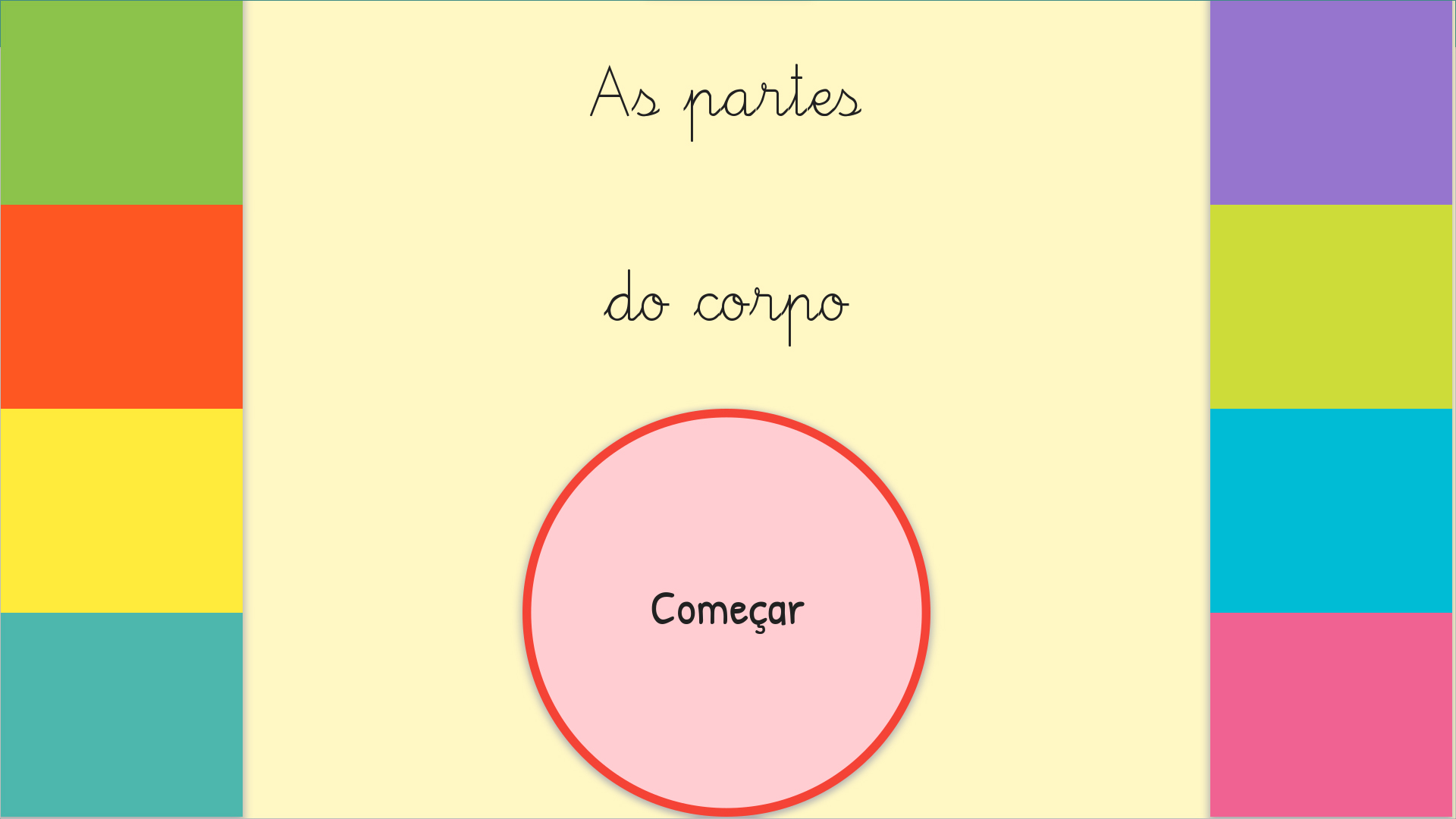
Partes del cuerpo
pt
(En
portugués)
Encuentra la imagen de la parte del cuerpo indicada entre tres opciones.
Compartido por: Adapt4you

Juego de suma sencillo
pt
(En
portugués)
Actividad de suma simple con números enteros. Según el cálculo propuesto en cada nivel, la manzana con la respuesta correcta.
Compartido por: Adapt4you

Cantidades
pt
(En
portugués)
Observa las imágenes y responde la pregunta sobre cantidades.
Compartido por: Adapt4you

Las mariquitas
pt
(En
portugués)
¿Cuántas mariquitas hay? Muchos, pocos, uno o ninguno.
Compartido por: Adapt4you

Sumas - restas
pt
(En
portugués)
La finalidad de las matemáticas en educación primaria es construir los fundamentos del razonamiento lógico – matemático, ya que es imprescindible hacer que el alumnado reflexione y no limitar su educación a la memorización de conceptos. Es por eso por lo que hemos creado una serie de tableros donde podemos trabajar las operaciones aritméticas básicas (sumas, restas, multiplicación y división) al mismo tiempo que potenciamos la resolución de problemas y cálculo mental. En el tablero Sumas y restas contiene una breve explicación con ejemplos de ambas operaciones y una serie de actividades ordenadas en tres niveles de dificultad.
Compartido por: Adapt4you

Sujeto - Predicado
pt
(En
portugués)
Aprender cómo se estructura una oración simple y ser capaces de diferencias las partes que la componen es importante para el correcto desarrollo del lenguaje, tanto verbal como no verbal. Con este nuevo tablero queremos trabajar de manera dinámica las oraciones atendiendo a esas cuestiones, comprendiendo cuál es la diferencia entre sujeto y predicado, cómo identificarlos y qué papel desarrolla cada uno. El material cuenta con una breve pero precisa explicación y una serie de actividades para afianzar los conocimientos trabajados. Las diferentes actividades que componen este tablero nos ofrece la posibilidad de guardas las respuestas de las y los usuarios para poder valorarlas con detenimiento y corregirlas, dando la opción de usar este material como examen adaptado.
Compartido por: Adapt4you

Formas geométricas irregulares
pt
(En
portugués)
¿Qué forma geométrica encaja? Diferentes formas con diferentes formatos que ayudarán al usuario a identificar el ajuste perfecto. Gran actividad para pequeños y mayores.
Compartido por: Adapt4you

Siluetas - Medios de transporte
pt
(En
portugués)
¿Puedes identificar el medio de transporte mencionado en la pregunta por su silueta?
Compartido por: Adapt4you

Vocabulario Halloween
pt
(En
portugués)
Actividad para introducir nuevos pictogramas en el vocabulario. Diseñado con diferentes páginas y vocabulario relacionado con la temática de Halloween.
Compartido por: Adapt4you

Discriminación visual Halloween
pt
(En
portugués)
Actividad ambientada para la fiesta de Halloween para trabajar la discriminación visual y el conteo. Consiste en encontrar el objeto indicado dentro de un conjunto de otros objetos similares.
Compartido por: Adapt4you
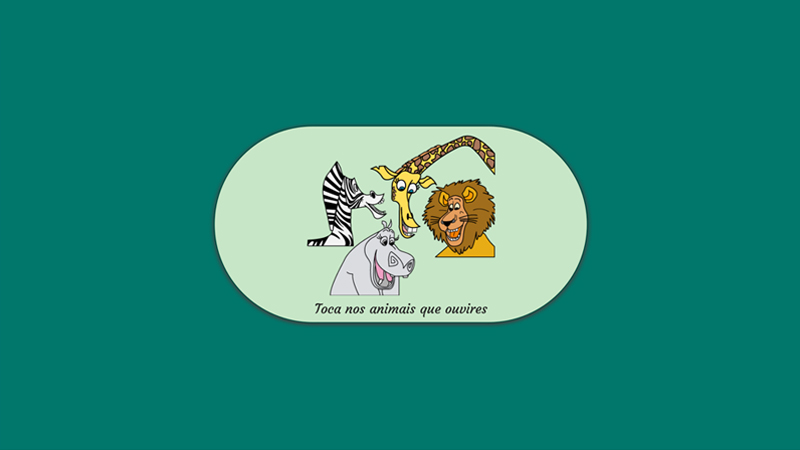
Entrenamiento táctil con animales 3
pt
(En
portugués)
Tablero diseñado para trabajar, mediante estímulos, el entrenamiento táctil. Juego que nos permite trabajar el reconocimiento y la discriminación entre dos animales, el sonido que emiten, además de la anticipación de alguna actividad programada con animales.
Los tres tableros Entrenamiento táctil animal funcionan igual pero el estímulo aparece más pequeño conforme subimos de nivel.
- Control motórico y de acceso a los comunicadores dinámicos.
- Reconocer y discriminar los diferentes estímulos.
- Aprender el funcionamiento de los comunicadores dinámicos.
Compartido por: Adapt4you

Entrenamiento táctil con animales 2
pt
(En
portugués)
Tablero diseñado para trabajar, mediante estímulos, el entrenamiento táctil. Juego que nos permite trabajar el reconocimiento y la discriminación entre dos animales, el sonido que emiten, además de la anticipación de alguna actividad programada con animales.
Los tres tableros Entrenamiento táctil animal funcionan igual pero el estímulo aparece más pequeño conforme subimos de nivel.
- Control motórico y de acceso a los comunicadores dinámicos.
- Reconocer y discriminar los diferentes estímulos.
- Aprender el funcionamiento de los comunicadores dinámicos.
Compartido por: Adapt4you

Entrenamiento táctil con animales 1
pt
(En
portugués)
Tablero diseñado para trabajar, mediante estímulos, el entrenamiento táctil. Juego que nos permite trabajar el reconocimiento y la discriminación entre dos animales, el sonido que emiten, además de la anticipación de alguna actividad programada con animales.
Los tres tableros Entrenamiento táctil animal funcionan igual pero el estímulo aparece más pequeño conforme subimos de nivel.
- Control motórico y de acceso a los comunicadores dinámicos.
- Reconocer y discriminar los diferentes estímulos.
- Aprender el funcionamiento de los comunicadores dinámicos.
Compartido por: Adapt4you

Entrenamiento de color
pt
(En
portugués)
Actividad diseñada para trabajar, mediante estímulos, el entrenamiento en el tacto de la pantalla táctil y el reconocimiento de colores.
Compartido por: Adapt4you

Rutina Playa
pt
(En
portugués)
Las rutinas son todas aquellas actividades o acciones que llevamos a cabo en nuestro día a día de manera regular y sistemática, es decir, se trata de hábitos o costumbres que adquirimos tras repetirlos muchas veces y que, posteriormente, realizamos de manera automática y sin que impliquen un sobre esfuerzo de razonamiento. Para muchas personas, niños/as y adultos/as, estas actividades diarias suponen un problema añadido a su día a día, por lo que es necesario trabajarlas desde la anticipación y la práctica diaria, marcando y reforzando cada uno de los pasos o secuencias de las que se componen. Comprender y automatizar estas tareas, se traduce en la comprensión y estructuración de sus días y del mundo que les rodea y en el cual deben interactuar y participar. Para esta comprensión y posterior automatización, se hace necesario un proceso importante de aprendizaje y apoyo, de ahí que hayamos creado, gracias a Eneso Verbo, una serie de tableros basados en rutinas diarias, con el objetivo de apoyar este proceso de anticipación, aprendizaje y automatización de las distintas rutinas diarias. Con este recurso trabajaremos las distintas secuencias necesarias para aprender la rutina de ir a la playa.
Compartido por: Adapt4you

Rutina Piscina
pt
(En
portugués)
Para muchas personas, niños/as y adultos/as, estas actividades diarias suponen un problema añadido a su día a día, por lo que es necesario trabajarlas desde la anticipación y la práctica diaria, marcando y reforzando cada uno de los pasos o secuencias de las que se componen. Comprender y automatizar estas tareas, se traduce en la comprensión y estructuración de sus días y del mundo que les rodea y en el cual deben interactuar y participar. Para esta comprensión y posterior automatización, se hace necesario un proceso importante de aprendizaje y apoyo, de ahí que hayamos creado, gracias a Eneso Verbo, una serie de tableros basados en rutinas diarias, con el objetivo de apoyar este proceso de anticipación, aprendizaje y automatización de las distintas rutinas diarias. Con este recurso trabajaremos las distintas secuencias necesarias para aprender la rutina de ir a la piscina.
Compartido por: Adapt4you

Encuentra el par II
pt
(En
portugués)
¡Continuación de la actividad "Encuentra el par I", con niveles más desafiantes! Esta actividad tiene como objetivo encontrar la misma imagen que la presentada inicialmente. Con imágenes reales para trabajar también con jóvenes, adultos y personas mayores. Su enfoque principal es el reconocimiento de patrones, colores, imágenes y formas.
Compartido por: Adapt4you

Encuentra el par I
pt
(En
portugués)
Esta actividad tiene como objetivo encontrar la misma imagen que la presentada inicialmente. Con imágenes reales para trabajar también con jóvenes, adultos y personas mayores. Su enfoque principal es el reconocimiento de patrones, colores, imágenes y formas.
Compartido por: Adapt4you

Veo veo
es
Todos conocemos este famoso juego del Veo Veo al que hemos recurrido en multitud de ocasiones para hacer más ameno un viaje o para entretenernos en situaciones concretas. Con este nuevo recurso de Verbo, podremos jugar a este juego tan divertido y versátil, además de utilizarlo como actividad para apoyar determinados procesos de aprendizaje.
Este tipo de juegos o de actividades, estimulan la creatividad de los/as niños/as, ya que tienen que buscar y encontrar objetos, por lo que favorece el desarrollo del pensamiento creativo, la atención, la concertación y la agudeza y discriminación visual.
Además de todo lo mencionado, se trata de un recurso perfecto para poder trabajar conciencia fonológica, en concreto, conciencia fonémica. Al tener que discriminar y localizar los objetos a través del sonido vocálico por el que empiezan, el juego del Veo Veo se traduce en un material muy útil para la adquisición de esta habilidad tan importante para el aprendizaje de la lectura y la escritura.
Podrás utilizar este recurso como juego, como actividad y/o como recurso evaluable, ya que cuenta con la posibilidad de guardar las respuestas en formato PDF.
Compartido por: Eneso

Rutina: ¡Vamos a la piscina!
es
Para muchas personas, niños/as y adultos/as, estas actividades diarias suponen un problema añadido a su día a día, por lo que es necesario trabajarlas desde la anticipación y la práctica diaria, marcando y reforzando cada uno de los pasos o secuencias de las que se componen.
Comprender y automatizar estas tareas, se traduce en la comprensión y estructuración de sus días y del mundo que les rodea y en el cual deben interactuar y participar. Para esta comprensión y posterior automatización, se hace necesario un proceso importante de aprendizaje y apoyo, de ahí que hayamos creado, gracias a Eneso Verbo, una serie de tableros basados en rutinas diarias, con el objetivo de apoyar este proceso de anticipación, aprendizaje y automatización de las distintas rutinas diarias.
Con este recurso trabajaremos las distintas secuencias necesarias para aprender la rutina de ir a la piscina.
Compartido por: Eneso

Rutina: ¡Vamos a la playa!
es
Las rutinas son todas aquellas actividades o acciones que llevamos a cabo en nuestro día a día de manera regular y sistemática, es decir, se trata de hábitos o costumbres que adquirimos tras repetirlos muchas veces y que, posteriormente, realizamos de manera automática y sin que impliquen un sobre esfuerzo de razonamiento.
Para muchas personas, niños/as y adultos/as, estas actividades diarias suponen un problema añadido a su día a día, por lo que es necesario trabajarlas desde la anticipación y la práctica diaria, marcando y reforzando cada uno de los pasos o secuencias de las que se componen.
Comprender y automatizar estas tareas, se traduce en la comprensión y estructuración de sus días y del mundo que les rodea y en el cual deben interactuar y participar. Para esta comprensión y posterior automatización, se hace necesario un proceso importante de aprendizaje y apoyo, de ahí que hayamos creado, gracias a Eneso Verbo, una serie de tableros basados en rutinas diarias, con el objetivo de apoyar este proceso de anticipación, aprendizaje y automatización de las distintas rutinas diarias.
Con este recurso trabajaremos las distintas secuencias necesarias para aprender la rutina de ir a la playa.
Compartido por: Eneso

Sinónimos-Antónimos
pt
(En
portugués)
Los sinónimos son palabras distintas pero que significan lo mismo, mientras que los antónimos son palabras que significan lo contrario. A priori son dos conceptos que parecen fáciles de entender y poner en práctica, pero que en la realidad resultan trabajosos y complicados, debido a que se trata de dos conceptos opuestos. Con este nuevo recurso de material curricular adaptado queremos enseñar qué son y cómo pueden enriquecer nuestro lenguaje cotidiano los sinónimos y los antónimos, ya que son grandes aliados en los procesos de construcción del léxico y en los procesos de lectoescritura. Este material se compone de una breve explicación con ejemplos y tres actividades diferentes, una de ellas que funciona a través de un enlace externo que le llevará a una página web. Las diferentes actividades que componen esta adaptación de material curricular nos ofrecen la posibilidad de guardar las respuestas dadas para valorarlas con detenimiento o utilizar el material como examen adaptado.
Compartido por: Adapt4you

Verdadero o falso
pt
(En
portugués)
La comprensión lectora o lectura comprensiva hace referencia a la capacidad que tenemos de comprender lo que hemos leído, no solo en el significado individual de cada una de las palabras que compongan la oración o el texto que estemos leyendo, si no del sentido y significado de esa oración o ese texto. Hemos desarrollado diferentes tableros, con los que poder trabajar comprensión lectora y desarrollar estrategias que nos ayuden en el trabajo de esta competencia. Este es un juego de Verdadero/Falso, en el que nos encontraremos diferentes textos, de menor a mayor dificultad divididos en niveles, en el que tendremos que responder a ciertas preguntas o afirmaciones seleccionando V/F.
Compartido por: Adapt4you

Estimulación cognitiva
pt
(En
portugués)
Actividad para trabajar funciones ejecutivas, estimulación cognitiva, memoria, atención y concentración con niños/as y con personas mayores, mediante la discriminación de diferentes elementos. Permite adaptar cada nivel o página a las características de todos los usuarios. Este recurso, gracias a la posibilidad de convertir los tableros en PDF e imprimirlos con la que cuenta Verbo, podemos adaptarlo a aquellas personas que no están familiarizadas con los dispositivos electrónicos.
Compartido por: Adapt4you

Agudeza visual
pt
(En
portugués)
Las actividades y juegos basados en el desarrollo de la percepción o la discriminación visual son esencial para trabajar aspectos como la concentración, la agudeza visual, la atención y la asociación. Son perfectamente válidas tanto para niños/as como para adultos/as, ya que nos ayudarán a estimular el desarrollo cognitivo y a prevenir cualquier dificultad que pueda surgir en este sentido. A través de la percepción visual interpretamos y/o discriminamos todos aquellos estímulos externos visuales que se encuentran en nuestro entorno y que los hemos aprendido previamente, mientras que la agudeza visual es la capacidad que tiene nuestro sistema visual para poder distinguir los detalles de esos estímulos de manera clara y nítida.
Compartido por: Adapt4you

Absurdos verbales
es
Los absurdos verbales son frases en las que algunos de sus elementos son incoherentes.
Este recurso de Verbo presenta una actividad para trabajar los absurdos verbales ofreciendo diferentes niveles en los que tendremos que descubrir cuál es el absurdo verbal de cada oración, para poder escribir correctamente dicha frase.
Compartido por: Eneso

Alimentos y bebidas
es
Actividad sobre comida en español. En cada página genera un archivo pdf.
Compartido por: Benelli Massimo

Reino animal
es
Este tablero es una digitalización y adaptación de los contenidos referentes al Reino Animal.
Compartido por: Eneso

Masculino y femenino
pt
(En
portugués)
La actividad Masculina y Femenina nos permite aprender y trabajar, de forma dinámica y divertida, el género de las palabras, sabiendo distinguirlo y pudiendo utilizarlo correctamente en una oración, en un texto o en una situación comunicativa. La actividad cuenta con explicaciones y actividades que reforzarán el aprendizaje. Las diferentes actividades que componen esta adaptación del material curricular nos dan la posibilidad de guardar las respuestas dadas por los usuarios y así evaluarlas detenidamente o utilizar el material como un examen adaptado.
Compartido por: Adapt4you

Tablero inicio: Matemáticas
es
Con este recurso podrás tener, en una sola carpeta, una colección de tableros para trabajar las distintas matemáticas. Los tableros “Inicio” nos permiten conectar diferentes tipos de materiales para que el trabajo de determinadas competencias y contenidos se realice de manera más sencilla, rápida y sin tener que cerrar, buscar y abrir los distintos recursos que necesitemos. Desde nuestro tablero Inicio podremos acceder a todos los tableros correspondientes a matemáticas y, a su vez, desde estos últimos tableros, volver al inicio.
Compartido por: Eneso
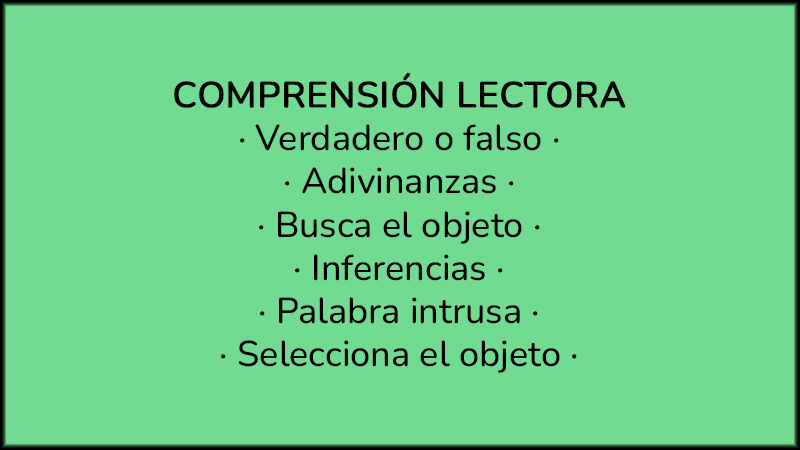
Tablero inicio: Comprensión lectora
es
Con este recurso podrás tener, en una sola carpeta, una colección de tableros para trabajar las distintas comprensión lectora]. Los tableros “Inicio” nos permiten conectar diferentes tipos de materiales para que el trabajo de determinadas competencias y contenidos se realice de manera más sencilla, rápida y sin tener que cerrar, buscar y abrir los distintos recursos que necesitemos. Desde nuestro tablero Inicio podremos acceder a todos los tableros correspondientes a comprensión lectora] y, a su vez, desde estos últimos tableros, volver al inicio.
Compartido por: Eneso

Tablero inicio: Categorías gramaticales
es
Con este recurso podrás tener, en una sola carpeta, una colección de tableros para trabajar las distintas categorías gramaticales. Los tableros “Inicio” nos permiten conectar diferentes tipos de materiales para que el trabajo de determinadas competencias y contenidos se realice de manera más sencilla, rápida y sin tener que cerrar, buscar y abrir los distintos recursos que necesitemos. Desde nuestro tablero Inicio podremos acceder a todos los tableros correspondientes a categorías gramaticales y, a su vez, desde estos últimos tableros, volver al inicio.
Compartido por: Eneso

Reglas de acentuación
es
Las reglas de acentuación determinan dónde y cuándo llevarán tilde las palabras, además de proporcionarnos información sobre aquellas palabras que, independientemente de las reglas básicas de acentuación, llevarán tilde por su propia peculiaridad y características.
Aplicar las reglas de acentuación implica implica que sepamos dividir la palabra en sílabas, que entendamos qué es una sílaba tónica y una sílaba átona y, por último, que sepamos diferenciar los tipos de palabras más básicas (llanas, agudas y esdrújulas), además de entender cuando llevarán tilde cada una de ellas.
Con este nuevo recurso aprenderemos, de manera dinámica, qué son las sílabas átonas y tónicas, cuáles son las palabras llanas, agudas y esdrújulas y cómo y cuándo acentuarlas.
Las diferentes actividades que componen esta adaptación de material curricular, nos brindan la posibilidad de guardar las respuestas que den los/as usuarios/as y así valorarlas con detenimiento o utilizar el material como examen adaptado.
Compartido por: Eneso

Prefijos y sufijos
es
Hemos creado este tablero para explicar y trabajar prefijos y sufijos, que son elementos gramaticales que cambian el significado de la palabra que acompañan.
Este nuevo recurso de material curricular se compone de una breve explicación con ejemplos y actividades para afianzar los conocimientos trabajados.
Las diferentes actividades que componen esta adaptación de material curricular nos ofrecen la posibilidad de guardar las respuestas dadas para valorarlas con detenimiento o utilizar el material como examen adaptado.
Compartido por: Eneso

Sinónimos y antónimos
es
Los sinónimos son palabras distintas pero que significan lo mismo, mientras que los antónimos son palabras que significan lo contrario. A priori son dos conceptos que parecen fáciles de entender y poner en práctica, pero que en la realidad resultan trabajosos y complicados, debido a que se trata de dos conceptos opuestos.
Con este nuevo recurso de material curricular adaptado queremos enseñar qué son y cómo pueden enriquecer nuestro lenguaje cotidiano los sinónimos y los antónimos, ya que son grandes aliados en los procesos de construcción del léxico y en los procesos de lectoescritura.
Este material se compone de una breve explicación con ejemplos y tres actividades diferentes, una de ellas que funciona a través de un enlace externo que le llevará a una página web.
Las diferentes actividades que componen esta adaptación de material curricular nos ofrecen la posibilidad de guardar las respuestas dadas para valorarlas con detenimiento o utilizar el material como examen adaptado.
Compartido por: Eneso

Sujeto y predicado
es
Aprender cómo se estructura una oración simple y ser capaces de diferencias las partes que la componen es importante para el correcto desarrollo del lenguaje, tanto verbal como no verbal. Con este nuevo tablero queremos trabajar de manera dinámica las oraciones atendiendo a esas cuestiones, comprendiendo cuál es la diferencia entre sujeto y predicado, cómo identificarlos y qué papel desarrolla cada uno.
El material cuenta con una breve pero precisa explicación y una serie de actividades para afianzar los conocimientos trabajados.
Las diferentes actividades que componen este tablero nos ofrece la posibilidad de guardas las respuestas de las y los usuarios para poder valorarlas con detenimiento y corregirlas, dando la opción de usar este material como examen adaptado.
Compartido por: Eneso

Masculino y femenino
es
El tablero Masculino y Femenino nos permite aprender y trabajar, de manera dinámica y divertida, el género de las palabras, saber distinguirlo y poder utilizarlo correctamente en una oración, un texto o una situación comunicativa.
El material cuenta con explicaciones y actividades que reforzarán el proceso de aprendizaje.
Las diferentes actividades que componen esta adaptación de material curricular, nos brindan la posibilidad de guardar las respuestas que den los/as usuarios/as y así valorarlas con detenimiento o utilizar el material como examen adaptado.
Compartido por: Eneso

Singular y plural
es
El tablero Singular y Plural nos permite aprender y trabajar, de manera dinámica y divertida, el número de las palabras, saber distinguirlo y poder utilizarlo correctamente en una oración, un texto o una situación comunicativa.
El material cuenta con explicaciones y actividades que reforzarán el proceso de aprendizaje.
Las diferentes actividades que componen esta adaptación de material curricular, nos brindan la posibilidad de guardar las respuestas que den los/as usuarios/as y así valorarlas con detenimiento o utilizar el material como examen adaptado.
Compartido por: Eneso
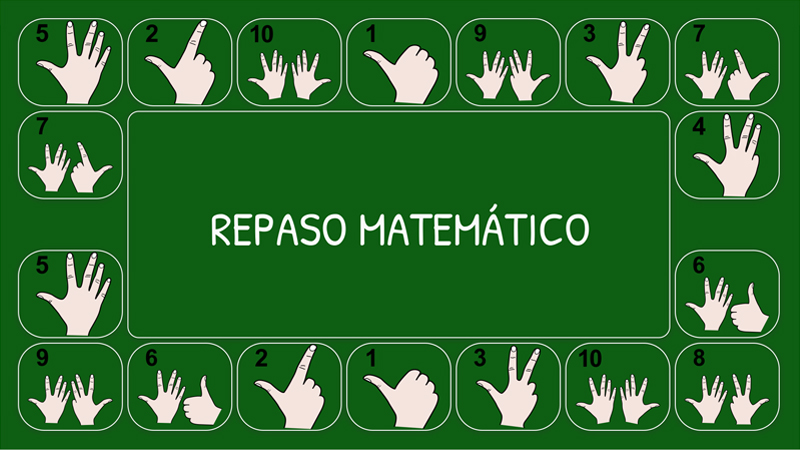
Repaso matemático
es
La finalidad de las matemáticas en educación primaria es construir los fundamentos del razonamiento lógico – matemático, ya que es imprescindible hacer que el alumnado reflexione y no limitar su educación a la memorización de conceptos.
Por ello hemos creado este tablero compilatorio de ejercicios matemáticos, pensados para repasar distintos contenidos de manera fácil, cómoda y divertida.
Este recurso reúne los siguientes contenidos: tableros matemáticos, problemas, tablas de multiplicar y actividad de repaso, números romanos y actividades, lectura y escritura de números de cuatro cifras. Todas las actividades se explican brevemente.
Las diferentes actividades que componen este tablero nos ofrecen la posibilidad de guardas las respuestas de las y los usuarios para poder valorarlas con detenimiento y corregirlas, dando la opción de usar este material como examen adaptado.
Compartido por: Eneso
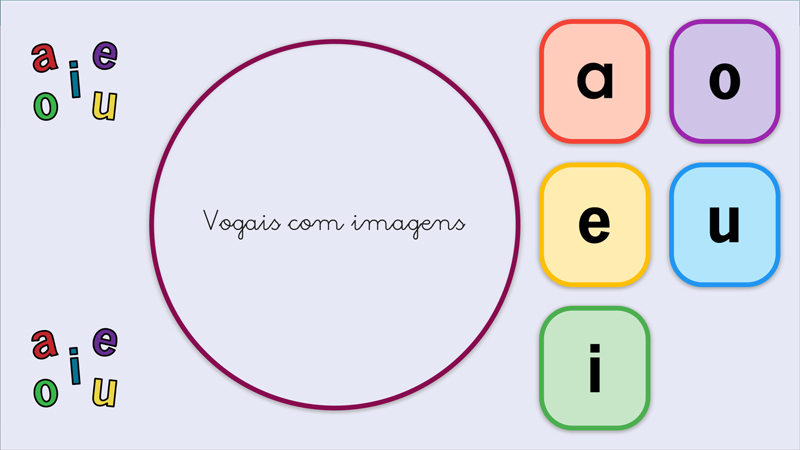
Vocales con imágenes
pt
(En
portugués)
La actividad “Vocales con Imágenes” es un recurso mediante el cual trabajaremos las vocales asociando su sonido al de diferentes objetos que empiezan con cada vocal, lo que ayudará a comprender que cada palabra está compuesta por diferentes sonidos y que cada fonema (letra ) tiene su propio sonido. Es un juego a través del cual podemos iniciar el proceso de aprender a leer. Objetivos: • Conocer las vocales. • Diferenciar entre los sonidos de las letras (vocales). • Asociar cada vocal con diferentes imágenes que comiencen con ese sonido.
Compartido por: Adapt4you

Números romanos
es
Antes de que los árabes trajesen a Europa su sistema de numeración, que es el que utilizamos hoy en día, hace mucho tiempo, en la Antigua Roma, los romanos inventaron un sistema de numeración que todavía seguimos utilizando para algunas cosas. Son lo que llamamos números romanos.
Con este tablero podremos aprender qué son, para qué y cómo se usan los números romanos. Encontrarás una breve explicación con ejemplos y las reglas básicas, y tres actividades para afianzar y repasar lo aprendido.
Compartido por: Eneso

Divisiones
es
La finalidad de las matemáticas en educación primaria es construir los fundamentos del razonamiento lógico – matemático, ya que es imprescindible hacer que el alumnado reflexione y no limitar su educación a la memorización de conceptos.
Es por eso por lo que hemos creado una serie de tableros donde podemos trabajar las operaciones aritméticas básicas (sumas, restas, multiplicación y división) al mismo tiempo que potenciamos la resolución de problemas y cálculo mental.
El tablero Divisiones contiene una breve explicación con ejemplos y una serie de actividades: operaciones, con dos niveles de dificultad, y problemas.
Compartido por: Eneso

Multiplicaciones
es
Hemos creado una serie de tableros donde podemos trabajar las operaciones aritméticas básicas (sumas, restas, multiplicación y división) al mismo tiempo que potenciamos la resolución de problemas y cálculo mental.
La finalidad de las matemáticas en educación primaria es construir los fundamentos del razonamiento lógico – matemático, ya que es imprescindible hacer que el alumnado reflexione y no limitar su educación a la memorización de conceptos.
En el tablero Multiplicaciones contiene una breve explicación con ejemplos, las tablas de multiplicar del 1 al 10, una actividad para repasar las tablas, una serie de multiplicaciones divididas en dos niveles de dificultad y problemas, donde el usuario deberá reflexionar antes de hacer las operaciones.
Compartido por: Eneso

Sumas y restas
es
La finalidad de las matemáticas en educación primaria es construir los fundamentos del razonamiento lógico – matemático, ya que es imprescindible hacer que el alumnado reflexione y no limitar su educación a la memorización de conceptos.
Es por eso por lo que hemos creado una serie de tableros donde podemos trabajar las operaciones aritméticas básicas (sumas, restas, multiplicación y división) al mismo tiempo que potenciamos la resolución de problemas y cálculo mental.
En el tablero Sumas y restas contiene una breve explicación con ejemplos de ambas operaciones y una serie de actividades ordenadas en tres niveles de dificultad.
Compartido por: Eneso

Palabras compuestas
es
Las palabras compuestas son el producto del proceso morfológico conocido como composición, es decir, son aquellas palabras que se forman a partid de la unión de dos raíces o lexemas que dan lugar a una nueva unidad sintáctica y semántica.
Esta nueva unidad es independiente de las que la componen, por lo que tiene sus propias reglas de acentuación y ortografía.
Con este nuevo recurso proponemos una adaptación de material curricular con el que trabajar la compresión y el aprendizaje de las palabras compuesta y de los diferentes tipos que las componen, mediante un juego que nos brinda la posibilidad de guardar las respuestas que den los/as usuarios/as y así valorarlas con detenimiento o utilizar el material como examen adaptado.
Compartido por: Eneso

Adverbios
es
Para cerrar la serie de tableros con los que trabajar las categorizas gramaticales, os dejamos este recurso para trabajar los adverbios. Como en todas las categorías gramaticales, se trata de un tipo de palabras que presentan bastante dificultad en su proceso de aprendizaje, por lo que requieren trabajo, práctica y apoyo para su comprensión, asimilación, aprendizaje y reconocimiento. Con este material podremos trabajarlos de manera dinámica ya que cuenta con explicaciones y ejemplos de todas las características y tipos de adverbios, además de actividades que apoyan la comprensión y el aprendizaje de los mismos. Las diferentes actividades que componen esta adaptación de material curricular, nos brindan la posibilidad de guardar las respuestas que den los/as usuarios/as y así valorarlas con detenimiento o utilizar el material como examen adaptado.
Compartido por: Eneso
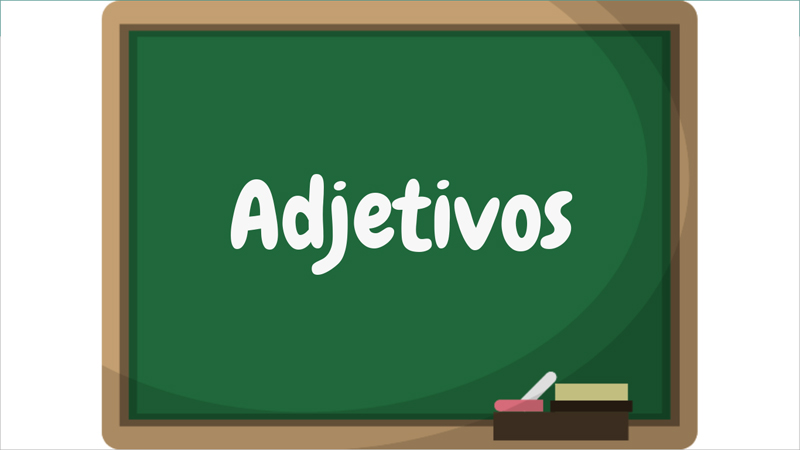
Adjetivos
es
Los adjetivos son aquellas palabras que acompañan al nombre o sustantivo, añadiendo información sobre él, como una cualidad o una característica que complementa su significado. Siempre concuerdan en género y número con los nombres o sustantivos.
Se trata de un tipo de palabra que guardan cierta complejidad debido a los diferentes usos que presenta y los diferentes grados en los que podemos usarlas.
Por ello, hemos desarrollado este recurso adaptado, con el objetivo de favorecer la compresión, la asimilación y el aprendizaje de los adjetivos, sus características, sus usos y sus grados.
Las diferentes actividades que componen esta adaptación de material curricular, nos brindan la posibilidad de guardar las respuestas que den los/as usuarios/as y así valorarlas con detenimiento o utilizar el material como examen adaptado.
Compartido por: Eneso

Verbos
es
Hemos preparado un tablero con el que trabajar los Verbos. Otro tipo de palabras que cuentan con bastante dificultad en su proceso de aprendizaje, por lo que necesitan bastante trabajo, práctica y apoyo para su comprensión, asimilación, aprendizaje y reconocimiento.
Con este material podremos trabajarlos de manera dinámica ya que cuenta con explicaciones y ejemplos de todas las características y peculiaridades de los verbos y actividades que apoyan la comprensión y el aprendizaje de los mismos.
Las diferentes actividades que componen esta adaptación de material curricular, nos brindan la posibilidad de guardar las respuestas que den los/as usuarios/as y así valorarlas con detenimiento o utilizar el material como examen adaptado.
Compartido por: Eneso

Tangram
pt
(En
portugués)
Actividad basada en el juego “Tangram”. A través de este recurso, en el que adaptamos y creamos una versión interactiva de Tangram, podemos crear diferentes figuras mientras trabajamos el reconocimiento de colores y formas geométricas planas.
Compartido por: Adapt4you
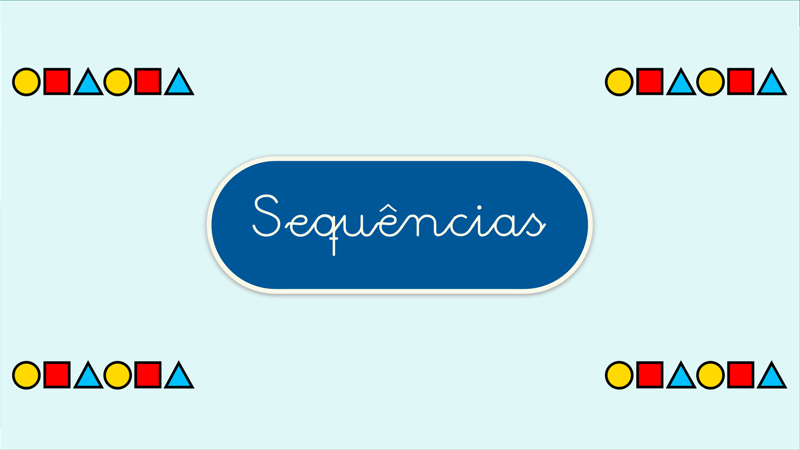
Seriaciones
pt
(En
portugués)
Actividad que cuenta con varias secuencias para trabajar la clasificación y organización de objetos. Las secuencias son un recurso fundamental en el trabajo con niños como ejercicio para trabajar y desarrollar el razonamiento lógico, la atención, la memoria, la concentración y las relaciones de orden. Como proceso mental, las secuencias son necesarias para aprender a comparar elementos, relacionarlos y ordenarlos en base a características comunes y/o un orden o patrón lógico. Objetivos: Desarrollar el razonamiento lógico. Potenciar la atención, la memoria y la asociación. Fomentar la discriminación y la percepción visual.
Compartido por: Adapt4you
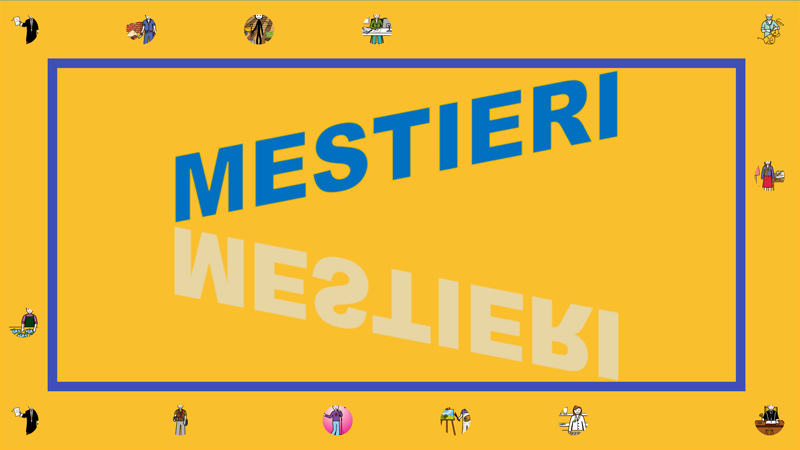
Oficios
it
(En
italiano)
Actividad donde tendremos que reconocer e identificar las distintas profesiones a través de pictogramas y relacionarlas con su nombre.
Compartido por: Benelli Massimo

Agudeza visual
es
Las actividades y juegos basados en el desarrollo de la percepción o la discriminación visual son esencial para trabajar aspectos como la concentración, la agudeza visual, la atención y la asociación. Son perfectamente válidas tanto para niños/as como para adultos/as, ya que nos ayudarán a estimular el desarrollo cognitivo y a prevenir cualquier dificultad que pueda surgir en este sentido.
A través de la percepción visual interpretamos y/o discriminamos todos aquellos estímulos externos visuales que se encuentran en nuestro entorno y que los hemos aprendido previamente, mientras que la agudeza visual es la capacidad que tiene nuestro sistema visual para poder distinguir los detalles de esos estímulos de manera clara y nítida.
Compartido por: Eneso
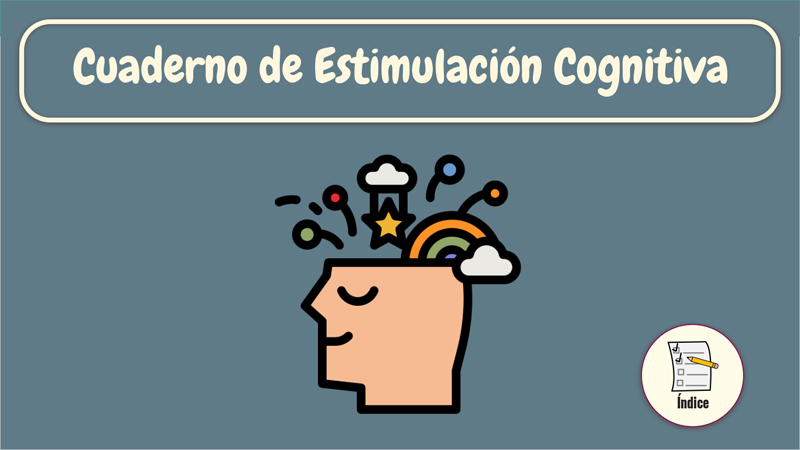
Cuaderno de estimulación cognitiva 2
es
Cuando hablamos de estimulación cognitiva, hacemos referencia a una serie de actividades, juegos y/o técnicas que nos ayudan a mejorar el funcionamiento de las capacidades cognitivas, tales como la orientación, la atención, la memoria, el lenguaje y las funciones ejecutivas, al mismo tiempo que trabajamos aspectos como las habilidades visoespaciales, las praxias o las gnosias.
Este nuevo Cuaderno de Estimulación Cognitiva cuenta con 14 tipos de actividades diferentes para poder trabajar con niños/as, adultos/as y personas mayores.
Compartido por: Eneso

Sudoku
es
El Sudoku es un pasatiempo de lógica, cuyo objetivo es rellenar las casillas ayudándonos de las imágenes, números o letras que ya estén colocados, sin repetir ninguno de ellos en la misma fila o columna.
Hemos adaptado el sudoku para hacerlo accesible desde Verbo y contar con esta actividad entre las muchas que forman la biblioteca de la Comunidad Verbo, ya que se trata de un gran recurso para trabajar lógica, razonamiento, atención, memoria y concentración.
Trabajar los sudokus con los/as niños/as, desde edades tempranas, y con personas mayores en intervención y estimulación cognitiva, conlleva numerosos beneficios para todos/as ellos/as, ya que implicar pensar a través de secuencias, desarrollar la comprensión espacial, el reconocimiento de patrones y la toma de decisiones al elegir el elemento que debemos de colocar en cada casilla.
Compartido por: Eneso

Verano 2022
it
(En
italiano)
Actividad interactiva en la que tendrás que preparar la maleta y seleccionar qué objetos son apropiado para pasar unos días de verano en la playa.
Compartido por: Benelli Massimo

Seriaciones
es
Tablero que cuenta con diferentes series planteadas para trabajar clasificación y organización de objetos.
Las series son un recurso esencial en el trabajo con los/as niños/as como ejercicio para trabajar y desarrollar el razonamiento lógico, la atención, la memoria, la concentración y las relaciones de orden.
Como proceso mental, las series son necesarias para aprender a comparar elementos, relacionarlos y ordenarlos en base a unas características comunes y/o un orden o patrón lógico.
Compartido por: Eneso

Tangram
es
Actividad basada en el juego del “Tangram”. A través de este recurso, en el que hemos adaptado y creado una versión interactiva del Tangram, podremos crear diferentes figuras al mismo tiempo que trabajamos reconocimiento de colores y de formas geométricas planas.
Compartido por: Eneso

Estimulación cognitiva y funciones ejecutivas
es
Actividad para trabajar funciones ejecutivas, estimulación cognitiva, memoria, atención y concentración con niños/as y con personas mayores, mediante la discriminación de diferentes elementos. Permite adaptar cada nivel o página a las características de todos los usuarios.
Este recurso, gracias a la posibilidad de convertir los tableros en PDF e imprimirlos con la que cuenta Verbo, podemos adaptarlo a aquellas personas que no están familiarizadas con los dispositivos electrónicos.
Compartido por: Eneso
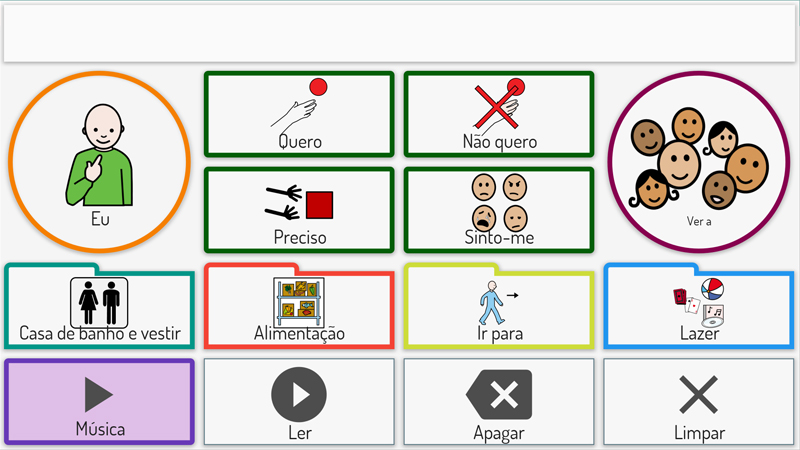
Actividades básicas
pt
(En
portugués)
Tablero de actividades básicas.
Compartido por: Ana

Emociones y estados de animo
it
(En
italiano)
Actividad donde tendrás que asociar emociones y estados de ánimo con los pictogramas de ARASAAC.
Compartido por: Benelli Massimo

Qué sentido usas
it
(En
italiano)
Actividad donde tendrás seleccionar qué sentido usas para realizar distintas acciones.
Compartido por: Benelli massimo

Tocar la batería
pt
(En
portugués)
¡Toca la batería con esta actividad! Estimula el tacto y la audición. Muy estimulante para los amantes de la música. Todavía hay otros instrumentos para tocar además de la batería. Actividad ideal para causa-efecto.
Compartido por: Adapt4you

Categorización
pt
(En
portugués)
¡Actividad de categorización! Ideal para trabajar el vocabulario de cada categoría. ¡Al final de la actividad puedes ver las respuestas que dio el niño/persona y también guardar las respuestas en PDF!
Compartido por: Adapt4you

Bandera Ucraniana
it
(En
italiano)
Colorea la bandera ucraniana. Haciendo clic en la palabra "peace" exporta a pdf y haciendo clic en la bandera vuelve a la página de inicio.
Compartido por: Benelli massimo

Colorea el dibujo
it
(En
italiano)
Juego de colorear
Compartido por: Benelli massimo

Ditongos
pt
(En
portugués)
Identificação dos vários sons dos ditongos com tarefas de identificação e localização. Estas atividades são dirigidas aos alunos do 1º ano de escolaridade e apoiam-se na metodologia dos Sons da Relicário.
Compartido por: Cercizimbra

Cercizimbra
pt
(En
portugués)
Identificación de los diversos sonidos vocálicos con tareas de identificación y localización. Estas actividades están dirigidas a los alumnos de 1º de escolaridad y se basan en la metodología de los Sonidos del Relicario.
Compartido por: Cercizimbra

Verano
pt
(En
portugués)
Ayuda a Pedro a ordenar las cartas para preparar la maleta para las fiestas.
Compartido por: Adapt4you

Memoria
pt
(En
portugués)
Juego de memoria con útiles escolares. Actividad útil para entrenar la memoria y promover la conversación sobre los útiles escolares.
Compartido por: Adapt4you

Intruso
pt
(En
portugués)
¡Descubre a los intrusos con esta actividad! El objetivo es elegir al intruso que está en 4 opciones. Gran actividad para promover la conversación entre pares.
Compartido por: Adapt4you

Rimas
pt
(En
portugués)
¡Rimas de los Santos Populares! San Antonio, San Juan y San Pedro son los santos más célebres de Portugal... ¿Puedes completar las rimas de estos santos?
Compartido por: Adapt4you
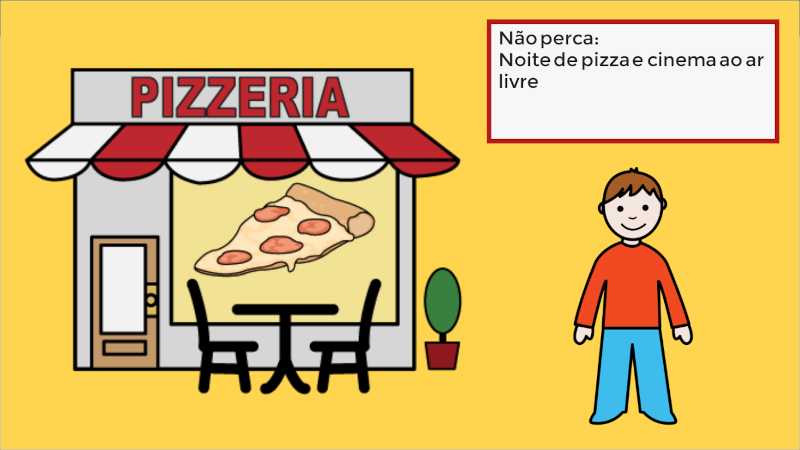
Noche de pizza
pt
(En
portugués)
¿Qué tal si tenemos una noche de pizza? ¡Para eso tenemos que aprender a hacer pizza! ¡En esta actividad aprendemos todos los pasos e ingredientes necesarios para la pizza perfecta! Al final puedes guardar la receta de pizza en PDF.
Compartido por: Adapt4you

Reloj
pt
(En
portugués)
Esta actividad trabaja el aprendizaje de horas. Se divide en dos actividades, una asociando las horas con las rutinas del día a día y la otra para configurar el reloj analógico según las horas del reloj digital.
Compartido por: Adapt4you

Primavera
pt
(En
portugués)
Actividad temática en primavera. ¡En primavera se estimulan los sentidos y esta actividad tiene como objetivo trabajar el conocimiento sobre los sentidos!
Compartido por: Adapt4you
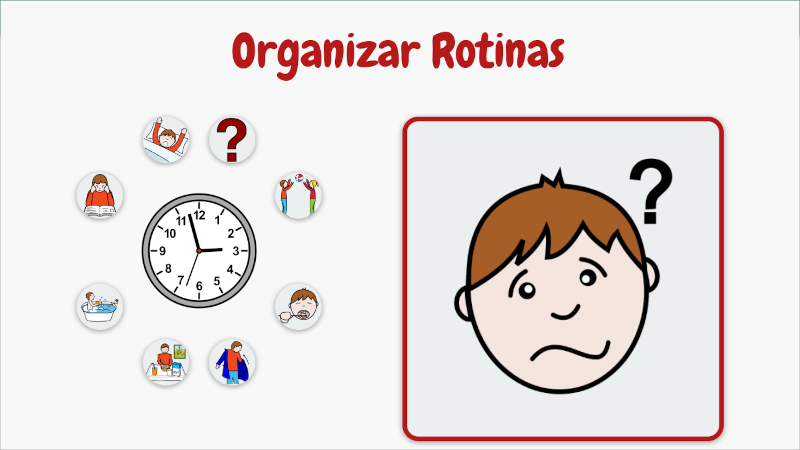
Secuenciar rutinas
pt
(En
portugués)
Actividad de secuencia de rutinas. El objetivo es poner en el orden correcto diferentes rutinas del día a día. Ayuda a la persona en la organización, asociación y secuencia de pasos.
Compartido por: Adapt4you

Aprender a reciclar
pt
(En
portugués)
Tablero donde se exponen los contenedores que existen, qué contienen y qué no se puede reciclar en ellos. Incluye una actividad para poner en práctica lo aprendido.
Compartido por: Adapt4you

Conciencia de las palabras
pt
(En
portugués)
Conciencia fonológica: conciencia de las palabras. Este es el primero de varios tableros del proyecto Adaptar. ¡Es fácil!
Compartido por: Cercizimbra

Cuantificar la duración de eventos
it
(En
italiano)
¿Cuánto duran los siguientes eventos?
Compartido por: Benelli massimo

Encuentra el intruso Navidad 2021
it
(En
italiano)
Cada página se exporta a pdf
Compartido por: Benelli massimo

Los instrumentos musicales 2
es
Escucha los sonidos de los instrumentos musicales y luego ubica cada uno de acuerdo al que pertenece.
Compartido por: Yelena Gaitan
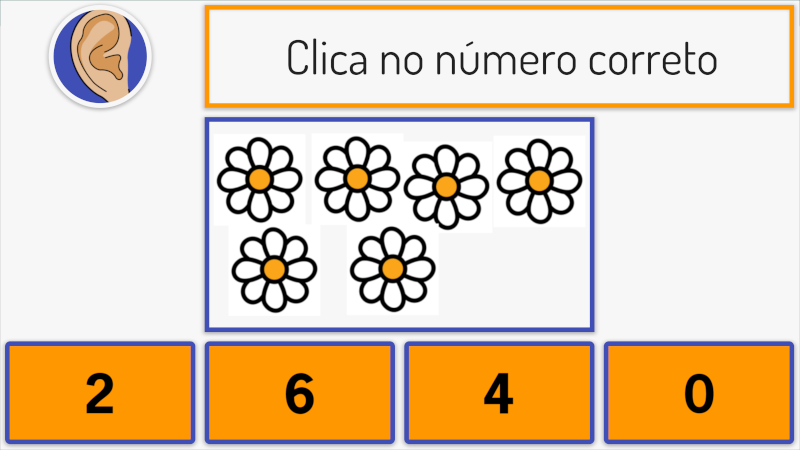
Número correcto
pt
(En
portugués)
Actividad de conteo, asociación numérica y cálculo.
Compartido por: Adapt4you

Actividad para contar
pt
(En
portugués)
¡Ejercicio para contar basada en disfraces!
Compartido por: Adapt4you

Aprende a utilizar el dinero
pt
(En
portugués)
Actividad educativa que consiste en seleccionar las monedas y billetes necesarios para llegar a un valor exacto. Las celdas con la respuesta correcta desaparecen cuando se presionan y proporcionan al usuario un refuerzo auditivo.
Compartido por: Adapt4you

Se mueve o no se mueve
pt
(En
portugués)
¿Se mueve o no se mueve?
Compartido por: Adapt4you

Matrículas antiguas
es
Tablero para hacer memoria sobre las antiguas matriculas españolas por provincias
Compartido por: Alejandro Andrés

Encuentra las letras
pt
(En
portugués)
Es una actividad para trabajar la percepción visual, consiste en encontrar una letra específica entre muchas otras similares a la que se quiere investigar. Hay cuatro niveles de dificultad, superando cada nivel que nos ofrece la actividad para repetir el nivel o pasar al siguiente.
Compartido por: Adapt4you

Selecciona el que es igual
pt
(En
portugués)
Actividad para seleccionar los pictogrames iguales. Ideal para asociar símbolos y coordinación ojo-mano. ¡Con diferentes niveles!
Compartido por: Adapt4you

Selecciona el que es igual
es
Se trata de una actividad para trabajar la memoria y la atención. Consiste en seleccionar el pictograma que se repite dentro de la misma fila. Posee un refuerzo positivo auditivo y la celda correcta se desvanece automáticamente al pulsarla.
El tablero está formado por 25 niveles y cada uno de ellos está asociado a una letra concreta del alfabeto.
Compartido por: Eneso

Ellememti fissi e mobili
es
Si muove o non si muove?
Compartido por: Benelli Massimo
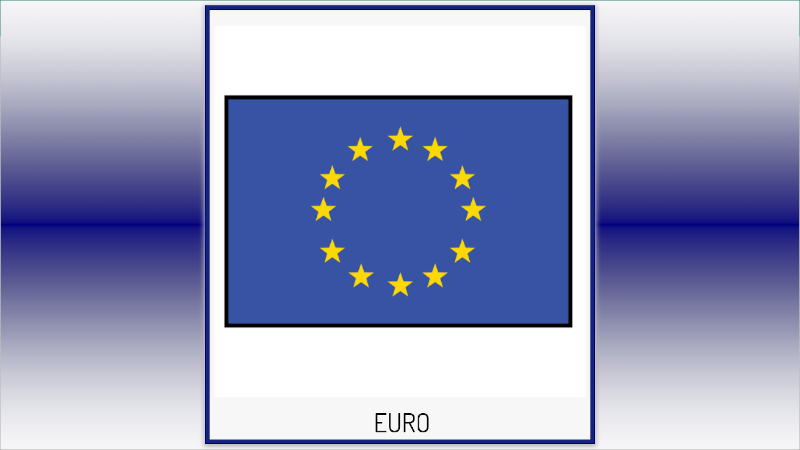
Cálculo en euros
pt
(En
portugués)
Actividad de sumas con monedas y céntimos de euro. Atiende al cálculo propuesto en cada nivel e indica la respuesta correcta entre tres opciones. Se trabaja el razonamiento matemático, la memoria, la atención y concentración así como la elección entre tres respuestas.
Compartido por: Adapt4you

Objetos eléctricos
it
(En
italiano)
Se trata de una actividad en la que hay que identificar qué objetos necesitan electricidad para funcionar. Una página del tablero muestra pictogramas de diferentes objetos, todos se desvanecen al seleccionarlos, de esta forma posibilita evaluar las respuestas del usuario. En la página de resultados se pueden observar las respuestas correctas y las respuestas dadas por el usuario.
Compartido por: Benelli Massimo

Aprende a utilizar el dinero
es
Se trata de una actividad educativa que consiste en seleccionar las monedas y billetes que se necesitan para alcanzar una cantidad exacta. Las celdas con la respuesta correcta se desvanecen al pulsarlas y dan un refuerzo positivo auditivo al usuario. Las respuestas del usuario, se guardarán automáticamente en un documento .pdf.
Compartido por: Eneso

Encuentra las letras
es
Se trata de una actividad para trabajar la percepción visual, consiste en encontrar una letra concreta entre otras muchas que son similares a la que hay que buscar. Hay cuatro niveles de dificultad, al superar cada nivel la actividad nos ofrece repetir el nivel o pasar el siguiente.
Compartido por: Eneso

Orientación personal y temporal para personas mayores
es
El tablero está compuesto por diferentes páginas donde se invita al usuario a recordar su nombre, el lugar donde nació, el nombre de sus padres, el de sus hermanos y, entre muchas otras, la profesión a la que dedicó. Al final del tablero hay una actividad de orientación espacial para ubicar a la persona en la estación del año actual y para distinguir las prendas de ropa que se pondrían en función de la estación del año en la que estén.
Compartido por: Eneso

Discriminación entre objetos antiguos y objetos modernos
es
El tablero tiene como objetivo discriminar objetos antiguos de objetos modernos. Se presentan una serie de imágenes con objetos de diferentes épocas, la persona o personas que realicen la actividad deberán pulsar sobre “antiguo” o “moderno” según crean.
Compartido por: Eneso

Recuerda la imagen
it
(En
italiano)
Intenta encontrar la imagen que has visto hace unos segundos entre todas las demás.
Compartido por: Ausilionline
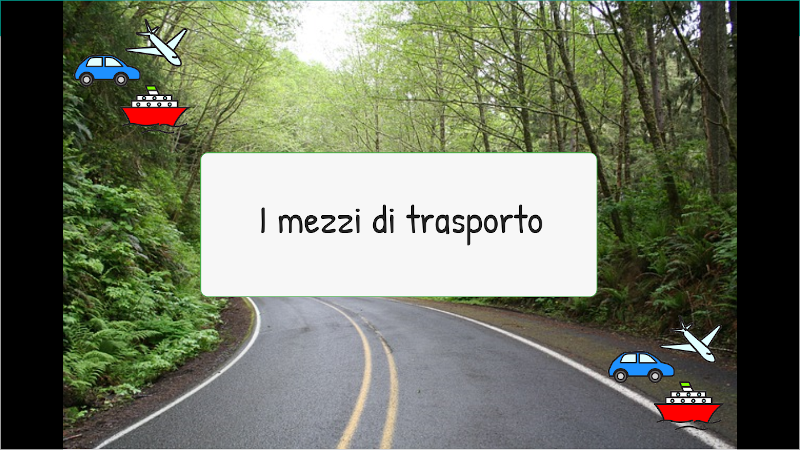
Medios de transporte
it
(En
italiano)
¿Puedes identificar el medio de transporte al que se refiere la pregunta a partir de su silueta?
Compartido por: Ausilionline

Intruso fácil
it
(En
italiano)
Actividad educativa en la que se debe indicar el elemento que no pertenece a la categoría común entre otras tres imágenes.
Compartido por: Ausilionline

Attiviata per il tempo libero_bambini
it
(En
italiano)
Tablero diseñado para ofrecer distintas actividades multimedia a los más pequeños organizado en tres páginas (mis vídeos, mis canciones y mis fotos) con enlaces para lanzar aplicaciones, que se personalizan para cada usuario.
Compartido por: Ausilionline
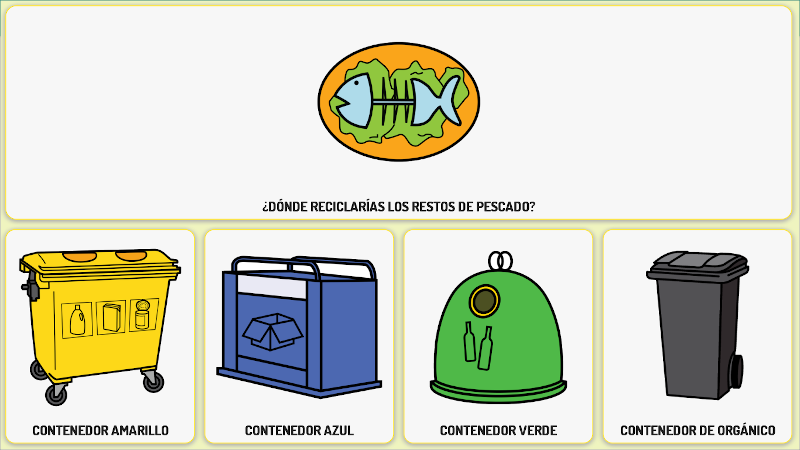
Aprende a reciclar, actividad y valoración de los resultados
es
Activad de evaluación que consiste en clasificar una serie de residuos en los distintos contendedores que existen. Los resultados se guardarán automáticamente en un archivo pdf.
Compartido por: Eneso
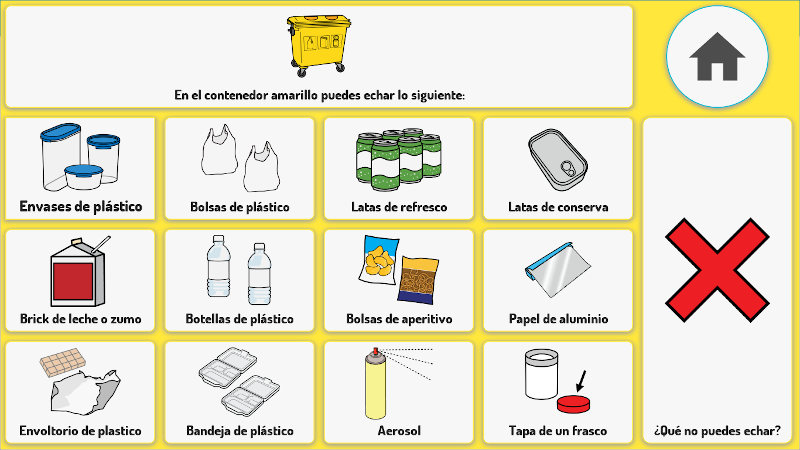
Aprende a reciclar, teoría y práctica
es
Tablero donde se exponen los contenedores que existen, qué contienen y qué no se puede reciclar en ellos. Incluye una actividad para poner en práctica lo aprendido.
Compartido por: Eneso

Aprende a reciclar, mapa conceptual y canción
es
Tablero sencillo donde se presentan los distintos contenedores que existen, de qué color son y qué contiene cada uno. De fondo, y a lo largo de todo el tablero, suena una melodía. Al final, en la última página, hay un enlace a un vídeo musical.
Compartido por: Eneso

Aprende a reciclar, esto va en...
es
Tablero de anticipación de una sola página que contiene los pictogramas de cuatro contenedores distintos. Lo podemos utilizar como herramienta a la hora de ir a reciclar.
Compartido por: Eneso

Batería Mario
es
Tablero de música: Percusión con bateríaContiene tres sets de batería y uno de distintos instrumentos. Para jugar, estimular visual y auditivamente y mejorar la coordinación, ya sea por barrido, selección directa, joystick, cursor o por manejo con la vista. ¡A disfrutar!
Compartido por: Charli y Mario

Las partes del día
it
(En
italiano)
Compartido por: Benelli Massimo

Juego de memoria
es
Juego de memoria con cartas
Compartido por: Rosa

Higiene personal
it
(En
italiano)
Compartido por: Benelli Massimo

Asocia la tienda
es
Asocia las imágenes a su tienda correspondiente.
Compartido por: Benelli Massimo

Formas geométricas
es
Encuentra la forma geométrica indicada: cuadrado, círculo, rectángulo, rombo, óvalo, esfera y cubo.
Compartido por: Charli y Mario

Concierto de rock
es
Mario monta un ¡Concierto de rock! En este tablero hay que ir seleccionado entre un montón de cosas: objetos, instrumentos, personas.. Elige lo necesario para montar un concierto de rock. La selección se hace durante varias paginas de dos celdas con imágenes o pictogramas.
Compartido por: Charli y Mario

Sólidos
it
(En
italiano)
¿Cuáles de estos elementos son sólidos?
Compartido por: Benelli Massimo

Ciencias naturales
it
(En
italiano)
Preguntas y respuestas sobre ciencias naturales. Este tablero muestra los resultados al final.
Compartido por: Benelli Massimo

Encuentra el intruso - Resultados
es
Actividad educativa en la que se debe indicar el elemento que no pertenece a la categoría común entre otras tres imágenes. Esta versión muestra al final una página con las respuestas del usuario y las esperadas.
Compartido por: Eneso

Recuerda las fotografías
es
Fíjate en las fotografías y recuerda los detalles para responder correctamente.
Compartido por: Eneso

Memoria visual
es
Juego de memoria visual. ¿Cuál es la imagen que ha cambiado?
Compartido por: Eneso

Busca el modelo
es
Selecciona el que es igual al modelo.
Compartido por: Eneso

Selecciona las imágenes iguales
es
Pulsa sobre las imágenes que son iguales.
Compartido por: Eneso

Juego de memoria auditiva
es
Actividad para utilizar con barrido auditivo. Pon a prueba tu memoria auditiva y responde a las preguntas.
Compartido por: Eneso

Elige la característica
es
Elige la característica más representativa de los siguientes conceptos.
Compartido por: Centro Háblame

Selecciona el número correcto
it
(En
italiano)
¿Cuántos hay? Tablero de actividad en italiano para seleccionar la cantidad correspondiente en cifras.
Compartido por: Benelli Massimo

Los instrumentos musicales
fr
(En
francés)
Descubre el sonido que produce cada instrumento musical y juega a intentar reconocerlos.
Compartido por: Domodep

Siluetas - Medios de transporte
fr
(En
francés)
¿Puedes identificar el medio de transporte al que se refiere la pregunta a partir de su silueta?
Compartido por: Domodep
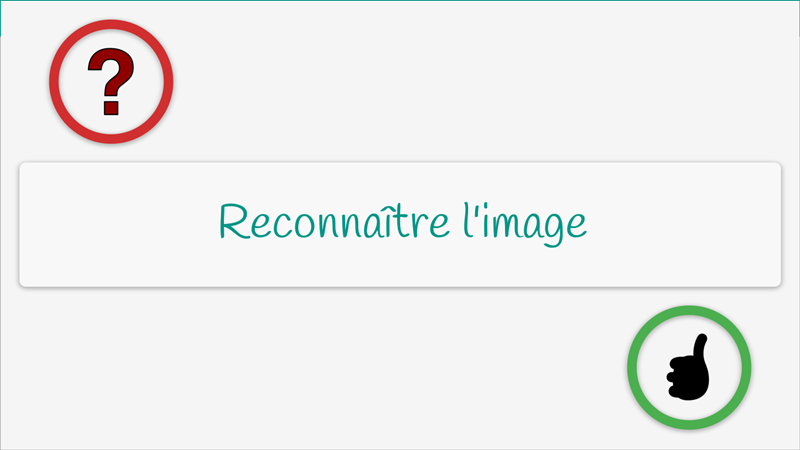
Recuerda la imagen
fr
(En
francés)
Intenta encontrar la imagen que has visto hace unos segundos entre todas las demás.
Compartido por: Domodep

Encuentra el intruso (difícil)
fr
(En
francés)
Actividad educativa en la que se debe indicar el elemento que no pertenece a la categoría común entre otras once imágenes.
Compartido por: Domodep

Encuentra el intruso (fácil)
fr
(En
francés)
Actividad educativa en la que se debe indicar el elemento que no pertenece a la categoría común entre otras tres imágenes.
Compartido por: Domodep

Secuencia de correos
it
(En
italiano)
Ordena las imágenes en función de lo que ocurre antes para realizar la secuencia de tareas para el envío postal.
Compartido por: Benelli Massimo

¿Qué sucedió antes?
es
Ordena las imágenes según el orden lógico de aparición en cada historia.
Compartido por: Eneso

Señales de tráfico
es
Identifica las señales de tráfico y conoce su significado.
Compartido por: Eneso

Recuerda el que falta
es
¿Qué animal falta? Recuerda las imagenes y selecciona el animal que se pierde. Tablero con sonidos reales grabados como reforzamientos.
Compartido por: Leticia (Amappace). Creado en el curso nivel III de Verbo.

Conocemos las profesiones
es
Observa la imagen y elige la profesión correspondiente.
Compartido por: Raquel (Amappace). Creado en el curso nivel III de Verbo.

Elige el animal correcto
es
Selecciona el animal según la pregunta dada en cada nivel.
Compartido por: Ángeles Gil. Creado en el curso nivel III de Verbo.

Señales de tráfico
it
(En
italiano)
Identifica las señales de tráfico y conoce su significado.
Compartido por: Benelli Massimo

Medios de transporte
es
Tablero en italiano para responder distintas cuestiones sobre los medios de transporte.
Compartido por: Eneso

Las mariquitas
es
¿Cuántas mariquitas hay? Muchas, pocas, una o ninguna.
Compartido por: Eneso

Cantidades
es
Observa las imágenes y responde a la pregunta sobre cantidades.
Compartido por: Eneso

Números en cifras
it
(En
italiano)
Lee o escucha el número escrito en letras y elige su cifra correspondiente.
Compartido por: Benelli Massimo

Actividad matemática
it
(En
italiano)
Actividad en italiano de preguntas y respuestas sobre las cantidades presentadas. Mira el dibujo y elige una de las tres opciones que representan su cantidad.
Compartido por: Benelli Massimo
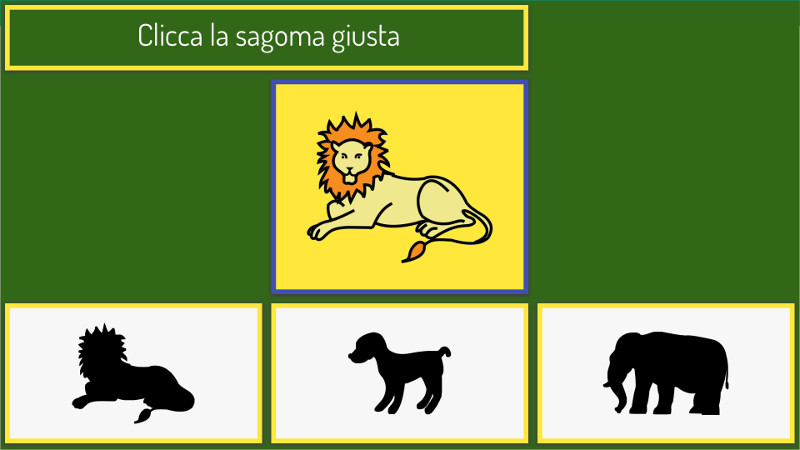
Siluetas de animales
it
(En
italiano)
Actividad en italiano para identificar la sombra de la imagen mostrada en la temática de animales.
Compartido por: Benelli Massimo

Cálculo con euros
es
Actividad de sumas con monedas y céntimos de euro. Atiende al cálculo propuesto en cada nivel e indica la respuesta correcta entre tres opciones.
Compartido por: Benelli Massimo

Juego de sumas simple
es
Actividad de sumas sencillas con números enteros. Atiende al cálculo propuesto en cada nivel la manzana con la respuesta correcta.
Compartido por: Eneso

Recuerda el símbolo Bliss (Inglés)
en
(En
inglés)
Intenta encontrar el símbolo Bliss que has visto hace unos segundos entre todos los demás. Adaptado para su uso con voz en inglés.
Compartido por: Eneso

Intruso fácil Bliss (Inglés)
en
(En
inglés)
Actividad educativa en la que se debe indicar el símbolo Bliss que no pertenece a la categoría común entre otros tres conceptos. Adaptado para su uso con voz en inglés.
Compartido por: Eneso

Aprendo las emociones
es
Actividad para trabajar las emociones desde el reconocimiento visual de fotografías reales. Se incluyen cuatro emociones: alegría, miedo, tristeza e ira, que pueden ampliarse.
Compartido por: Eneso

Los instrumentos musicales
es
Descubre el sonido que produce cada instrumento musical y juega a intentar reconocerlos.
Compartido por: Eneso

Siluetas - Medios de transporte
es
¿Puedes identificar el medio de transporte al que se refiere la pregunta a partir de su silueta?
Compartido por: Eneso

Números mayores y menores
es
Juega a comparar números.
Compartido por: Eneso

Orientación temporal
es
¿Qué día es hoy? ¿Qué hora es? ¿Qué tiempo hace?
Compartido por: Eneso
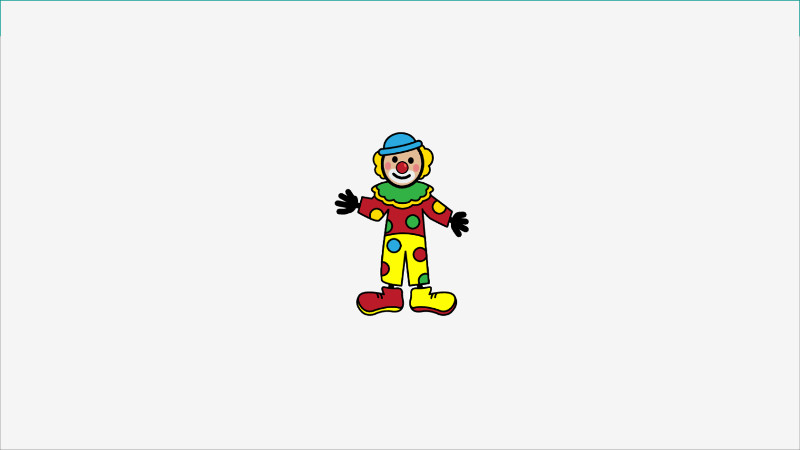
Recuerda la imagen
es
Intenta encontrar la imagen que has visto hace unos segundos entre todas las demás.
Compartido por: Eneso

Encuentra el intruso (difícil)
es
Actividad educativa en la que se debe indicar el elemento que no pertenece a la categoría común entre otras once imágenes.
Compartido por: Eneso

Encuentra el intruso (fácil)
es
Actividad educativa en la que se debe indicar el elemento que no pertenece a la categoría común entre otras tres imágenes.
Compartido por: Eneso






























































































































































